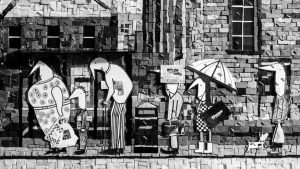Street Art at the Opus store
Street art is the art form of the people. It is probably the most accessible kind of art in the world. Anyone can make it, and anyone can view it. Street art isn’t just in a museum behind a piece of glass. It’s also on a brick wall and half covered by an advertisement for the latest Kanye West album.
Although street art has only gained popular acceptance in the last decade, it has roots that go back at least 40 years.
The graffiti in the New York City’s subway system in the 1970’s and 80’s influenced the first street artists like Jean-Michel Basquiat, Keith Haring, and Blek le Rat. Without graffiti, there might not be street art today.
The popularity of street art waned after Haring’s death in 1990, but in 1999 a revival began. That year, Banksy, the best-known living street artist, moved from freehand graffiti to his trademark stencil technique and some of New York City’s best known street artists (Swoon, Bast, Faile and others) started putting work on the street.
In 2006, headline-catching exhibitions across the USA brought street art into mainstream culture. Banksy’s “LA Extravaganza” exhibit introduced his work to Hollywood. In New York, the street art blog Wooster Collective brought together their favorite street artists to completely cover a building in artwork. Street art graduated from an underground movement to a popular culture phenomenon.
2008 was street art’s biggest year so far. In May, Banksy hosted Cans Festival, a London gathering of 40 of the world’s best stencil artists. They painted the entirety of a tunnel underneath Waterloo Station and visitors queued for hours to see the results. Later that same month, the Tate Modern had six of the world’s biggest names in street art decorate the outside of their museum and the thousands of Londoners who walked the Thames that summer could not help but look at the work.
Thanks to a dedicated fan-base and a number of talented artists, street art has become one of the most powerful and influential art movements so far in this century.


